Singapore Lubricants Market Size
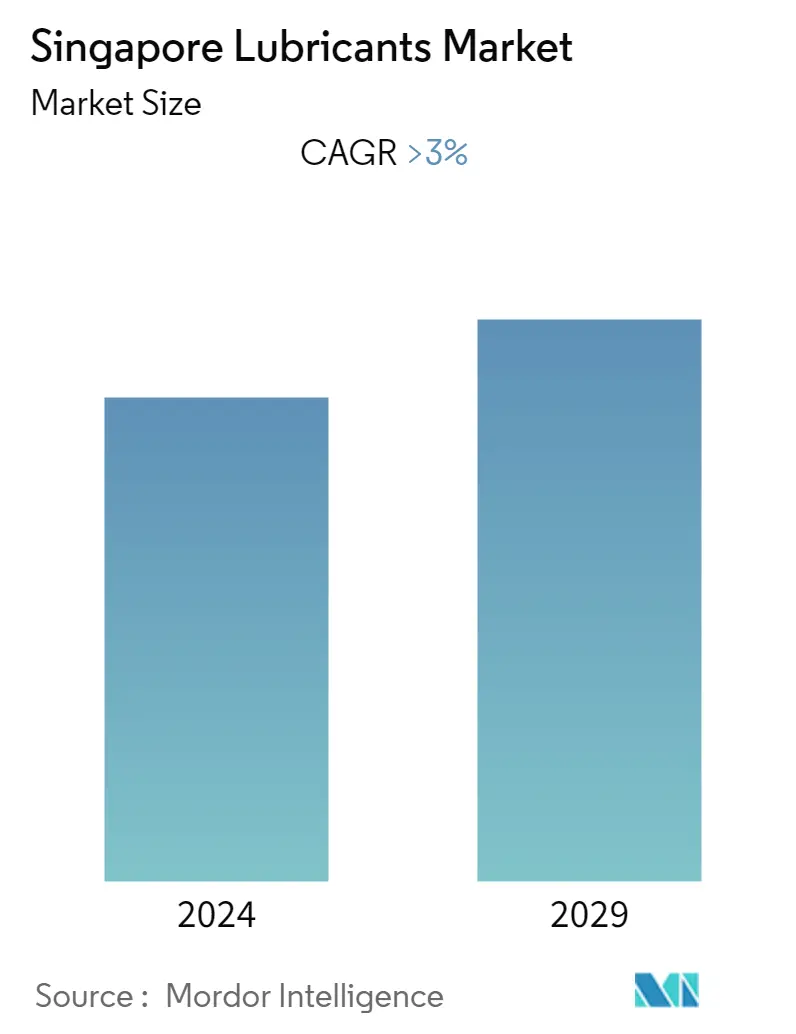
| Study Period | 2019 - 2029 |
| Base Year For Estimation | 2023 |
| Forecast Data Period | 2024 - 2029 |
| Historical Data Period | 2019 - 2022 |
| CAGR | 3.00 % |
| Market Concentration | Low |
Major Players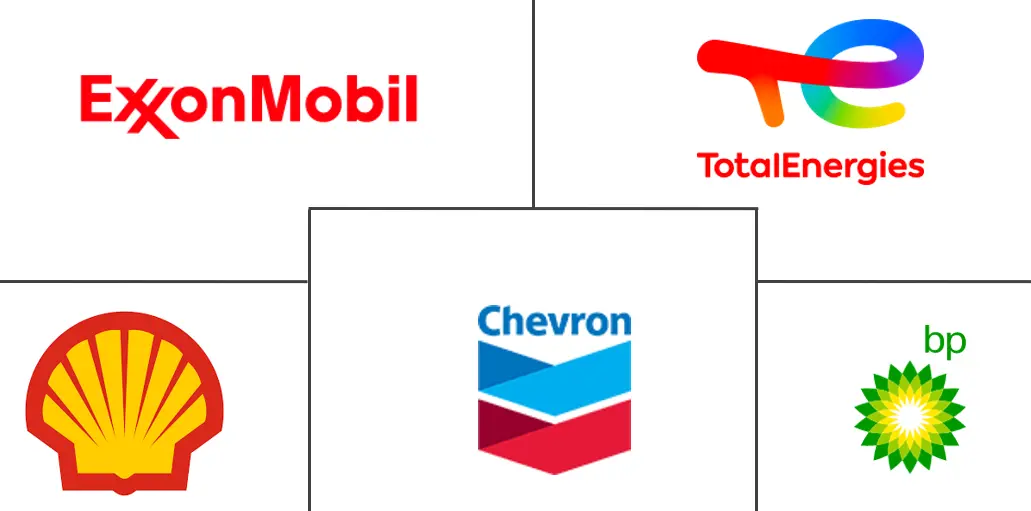
*Disclaimer: Major Players sorted in no particular order |
Singapore Lubricants Market Analysis
The Singapore lubricants market is expected to witness a CAGR of over 3% during the forecast period.
The COVID-19 outbreak in 2020 and the first half of 2021 significantly affected the industrial and automotive sectors, caused major production disruptions, and negatively affected customers' purchasing power in Singapore, limiting the Singapore lubricants market growth. However, the industry recovered well in 2022, as the situation became normal. The number of motor vehicles on the road in the country was 988,755 units by the end of 2022.
- Over the medium term, one of the major factors driving the market studied is the growing demand for new automotive vehicles.
- On the flip side, the growing adoption of electric vehicles will likely hinder the market's growth.
- Furthermore, the increasing adoption of bio-based lubricants is likely an opportunity.
- The automotive and other transportation industries dominated the market, expected to grow during the forecast period.
Singapore Lubricants Market Trends
This section covers the major market trends shaping the Singapore Lubricants Market according to our research experts:
Increasing Demand for Automotive Sector
- The automotive sector is the largest consumer of lubricants in Singapore. Lubricants are used in automobiles in engine oil, coolants, brake oil, and other transmission oils.
- Singapore is one of the Asia-Pacific region's most promising and fastest-growing vehicle markets. Several factors, including labor availability, R&D activities, location advantage, and government backing, support the automotive sector in Singapore.
- The Government of Singapore issues the Certificate of Entitlement (COE) to its citizens to state the right to vehicle ownership. In recent years, the government gave many COEs to the citizens, leading to higher vehicle sales.
- Furthermore, according to LTA (Land Transport Authority), as of the end of 2022, there was a total of approximately 995 thousand motor vehicles in Singapore. Passenger vehicles (PV) accounted for the largest share of 67% of the total number of on-road vehicles in 2022, followed by commercial cars (CVs) and motorcycles (MCs), with a share of 19% and 14%, respectively.
- Additionally, Singapore is considered the gateway for trade in the Asia-Pacific region, owing to the infrastructure and the logistic facilities available.
- Thus, the factors above are expected to impact the automotive industry, which, in turn, may affect the growth of the lubricant demand in the country.
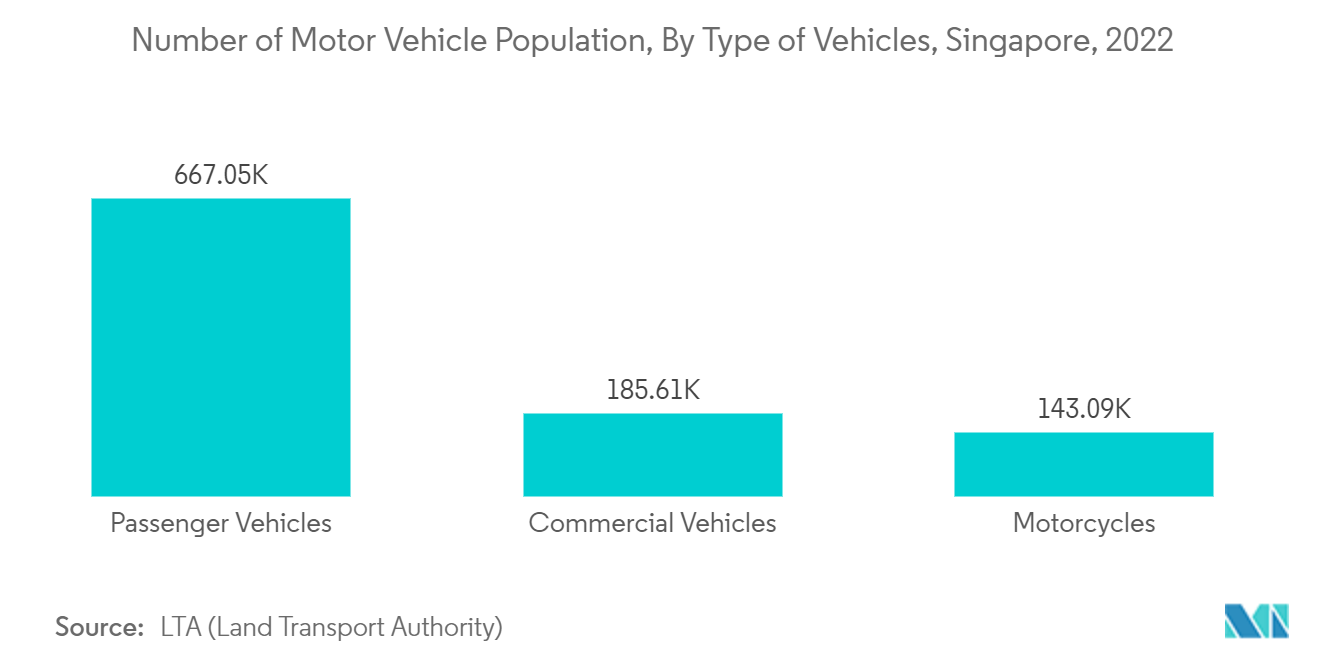
Engine Oil to Dominate the Market
- Engine oils form the leading product type due to their high volume requirements and short drain intervals, as they are used in high-temperature and high-pressure applications. It is often known as motor oil and is made to lubricate internal combustion engine parts, as well as to shield them from corrosion and keep them cool while operating.
- Engine oil is composed of two major components: base stock and additives. Typically, 95% of the solution comprises base stock derived from petroleum, synthetic chemicals, or a combination of the two. The base stock is in charge of dissipating accumulated heat and lubricating the moving elements of an engine.
- The additives, on the other hand, make up around 5% of the oil, and it is these compounds in charge of precisely regulating the oil's lubricity and viscosity and shielding engine parts from wear. For instance, Zinc dialkyl dithiophosphate (ZDDP) is a commonly used additive for preventing wear, while magnesium sulphonates aid in the breakdown of pollutants and engine sludge.
- Engine oils find applications in various end-user industries, including automotive, power generation, heavy-duty equipment, and other industries. There are typically three types of engine oil such as mineral oil, semi-synthetic oil, and full synthetic oil.
- Engine oil consumption increases gradually as the population of motor vehicles increases in the country. For instance, according to the LTA, the number of motor vehicles in Singapore increased from 988,755 in 2021 to around 995,746 in 2022.
- With the increasing demand from various sectors in the country, engine oil consumption is expected to boost during the forecast period.
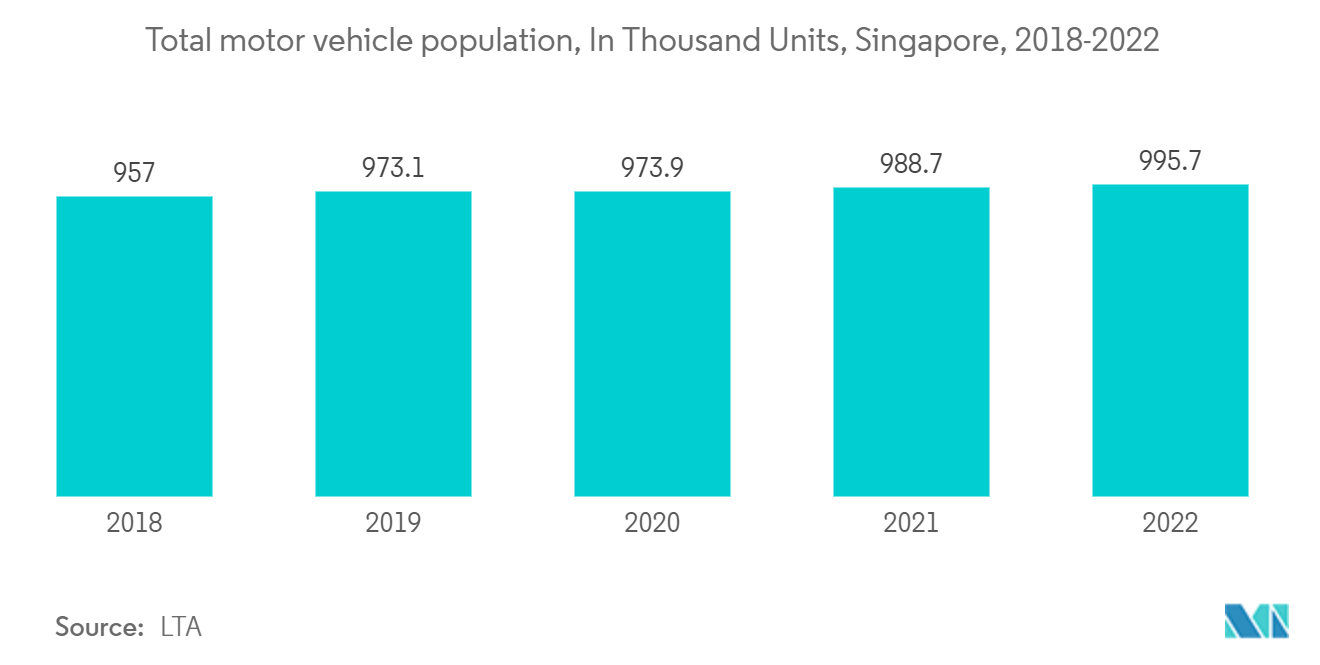
Singapore Lubricants Industry Overview
The Singapore lubricants market is fragmented in nature. Some of the major players in the market include (not in a particular manner) BP PLC (Castrol), Exxon Mobil Corporation, Shell plc, Chevron Corporation, and TotalEnergies SE.
Singapore Lubricants Market Leaders
-
Exxon Mobil Corporation
-
BP PLC (Castrol)
-
Chevron Corporation
-
Shell plc
-
TotalEnergies SE
*Disclaimer: Major Players sorted in no particular order
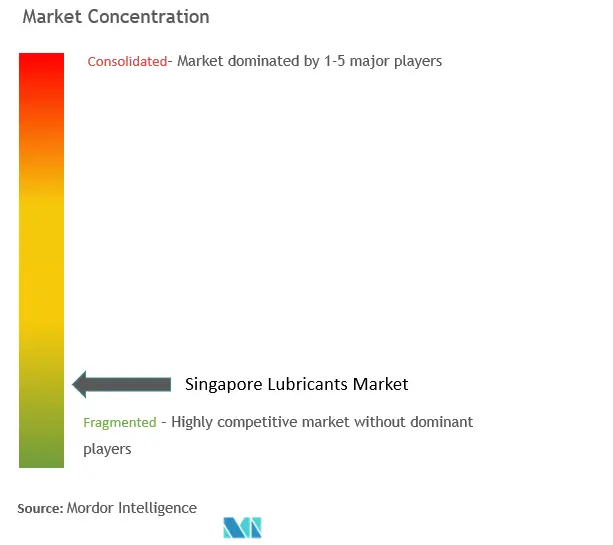
Singapore Lubricants Market News
- June 2022: ExxonMobil plans to upgrade its residual production into higher-value lubricant base stocks and cleaner fuels as part of its Singapore Resid Upgrade Project. The oil major is expected to add about 20,000 barrels per day of light, heavy, and extra-heavy lubricant base stocks when it completes upgrades at its Singapore integrated refining and petrochemical complex in 2025.
- March 2022: Motul expanded its presence all around the globe. The company launched a new, state-of-the-art Motul regional warehouse in Singapore, the Motul Asia Hub. The 700,000 sq ft facility support and enhances Motul's supply chain across the Asia-Pacific region by consolidating warehousing and inventory operations.
Singapore Lubricants Market Report - Table of Contents
1. INTRODUCTION
- 1.1 Study Assumptions
- 1.2 Scope of the Study
2. RESEARCH METHODOLOGY
3. EXECUTIVE SUMMARY
4. MARKET DYNAMICS
-
4.1 Drivers
- 4.1.1 Increasing Demand for New Automotive Vehicles
- 4.1.2 Active Ship Building and Repair Industry
-
4.2 Restraints
- 4.2.1 Growing Adoption of Electric Vehicles
- 4.2.2 Other Restraints
- 4.3 Value Chain / Supply Chain Analysis
-
4.4 Porter's Five Forces Analysis
- 4.4.1 Bargaining Power of Suppliers
- 4.4.2 Bargaining Power of Buyers/Consumers
- 4.4.3 Threat of New Entrants
- 4.4.4 Threat of Substitute Products
- 4.4.5 Intensity of Competitive Rivalry
5. MARKET SEGMENTATION (Market Size in Volume)
-
5.1 Product Type
- 5.1.1 Engine Oil
- 5.1.2 Transmission & Gear Oil
- 5.1.3 Metalworking Fluid
- 5.1.4 Hydraulic Fluid
- 5.1.5 Grease
- 5.1.6 Other Product Types
-
5.2 End-user Industry
- 5.2.1 Power Generation
- 5.2.2 Automotive
- 5.2.3 Heavy Equipment
- 5.2.4 Metallurgy and Metalworking
- 5.2.5 Other End-user Industries
6. COMPETITIVE LANDSCAPE
- 6.1 Mergers and Acquisitions, Joint Ventures, Collaborations, and Agreements
- 6.2 Market Share(%)**/Ranking Analysis
- 6.3 Strategies Adopted by Leading Players
-
6.4 Company Profiles
- 6.4.1 AP Oil
- 6.4.2 BP PLC (Castrol)
- 6.4.3 Chevron Corporation
- 6.4.4 Exxon Mobil Corporation
- 6.4.5 Fuchs
- 6.4.6 Idemitsu Kosan Co. Ltd
- 6.4.7 Motul
- 6.4.8 Shell plc
- 6.4.9 TotalEnergies SE
- 6.4.10 United Oil Company Pte Ltd
- *List Not Exhaustive
7. MARKET OPPORTUNITIES AND FUTURE TRENDS
- 7.1 Increasing Adoption of Bio-based Lubricants
Singapore Lubricants Industry Segmentation
A lubricant is a fluidic material that primarily reduces friction between surfaces that come into contact. Lubricant reduces energy loss caused by friction. At the same time, it can be beneficial in cleaning, cooling, and protecting metal parts from corrosion and rust and helps solve many other challenges a machine faces during operation. Singapore lubricants market is segmented by product type and end-user industry. By product type, the market is segmented into engine oils, greases, hydraulic fluids, metalworking fluids, transmission and gear oils, and other product types. By end-user industry, the market is segmented into automotive, heavy equipment, metallurgy and metalworking, power generation, and other end-user industries. For each segment, the market sizing and forecasts have been done based on volume (million liters).
| Product Type | Engine Oil |
| Transmission & Gear Oil | |
| Metalworking Fluid | |
| Hydraulic Fluid | |
| Grease | |
| Other Product Types | |
| End-user Industry | Power Generation |
| Automotive | |
| Heavy Equipment | |
| Metallurgy and Metalworking | |
| Other End-user Industries |
Singapore Lubricants Market Research FAQs
What is the current Singapore Lubricants Market size?
The Singapore Lubricants Market is projected to register a CAGR of greater than 3% during the forecast period (2024-2029)
Who are the key players in Singapore Lubricants Market?
Exxon Mobil Corporation, BP PLC (Castrol), Chevron Corporation, Shell plc and TotalEnergies SE are the major companies operating in the Singapore Lubricants Market.
What years does this Singapore Lubricants Market cover?
The report covers the Singapore Lubricants Market historical market size for years: 2019, 2020, 2021, 2022 and 2023. The report also forecasts the Singapore Lubricants Market size for years: 2024, 2025, 2026, 2027, 2028 and 2029.
Singapore Lubricants Industry Report
Statistics for the 2024 Singapore Lubricants market share, size and revenue growth rate, created by Mordor Intelligence™ Industry Reports. Singapore Lubricants analysis includes a market forecast outlook to 2029 and historical overview. Get a sample of this industry analysis as a free report PDF download.



